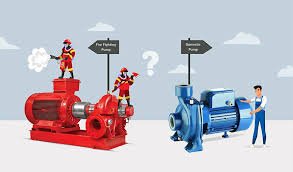
Jockey Pump vs Main Fire Pump: What’s the Difference?
When it comes to fire protection systems, reliability is non-negotiable. Two key components that often work hand-in-hand to ensure your fire suppression system is ready at all times are the jockey pump and the main fire pump. While both are integral to maintaining water pressure in fire sprinkler systems, they serve very different purposes. Understanding the difference between a jockey pump and a main fire pump can help facility managers, engineers, and property owners make informed decisions about system maintenance and design.
What Is a Jockey Pump?
A fire jockey pump is a small pump used to maintain pressure in a fire protection piping system. Its primary role is to compensate for small leaks and pressure drops, ensuring that the system remains pressurized and that the main fire pump does not turn on unnecessarily. By keeping the pressure steady, it prevents wear and tear on the main pump and ensures quicker activation during a real emergency.
- Flow Rate: Typically low (around 5–10 GPM)
- Pressure: Set slightly higher than the main pump
- Power: Operates on electricity
- Activation: Automatically turns on with minor pressure drops
In short, jockey pumps maintain system readiness without using the full power of the main fire pump.
What Is a Main Fire Pump?
The main fire pump is the backbone of a fire protection system. It kicks into action when there’s a significant drop in system pressure, usually caused by one or more sprinklers opening due to a fire. The main pump draws water from a water tank, reservoir, or municipal supply and delivers it at high pressure throughout the building’s sprinkler and hose systems.
- Flow Rate: Much higher (100–5000+ GPM depending on building size)
- Power Source: Electric motor or diesel engine
- Activation: Turns on when system pressure drops below a critical level
- Purpose: Delivers high-pressure water to suppress a fire
The main fire pump is designed for emergencies only, and unlike the fire jockey pump pressure, it should not run unless there’s a fire-related pressure drop.
Key Differences at a Glance
| Feature | Jockey Pump | Main Fire Pump |
|---|---|---|
| Purpose | Maintains pressure | Provides water during fire |
| Flow Rate | Low | High |
| Pressure Settings | Slightly above main pump | Operational pressure |
| Activation | Minor leaks or pressure drops | Fire event or large pressure drop |
| Power | Electric only | Electric or diesel |
| Usage Frequency | Often | Rare/emergency only |
Why Both Are Essential
Using both pumps together provides a layered protection system. The jockey pump acts as a guardian of pressure stability. Without it, minor drops in pressure (due to temperature changes, small leaks, or air release) would frequently trigger the main pump, leading to unnecessary wear, energy waste, and false alarms. On the other hand, the main pump ensures that in a real fire, the system delivers enough water at the necessary pressure to control or extinguish flames.
Maintenance Considerations
Both pumps require regular testing and maintenance:
- Jockey Pump Maintenance: Check operation weekly, inspect for leaks, verify electrical connections.
- Main Fire Pump Maintenance: Perform weekly or monthly test runs, inspect valves, check fuel (for diesel models), and maintain pump room temperature.
Neglecting either can lead to system failure during a fire emergency.
Read Also:-
- Why External Pumps Are Ideal for Industrial Applications
- Back Pull Out vs Traditional Pumps
- Diesel Fire Pump Startup Check List and Flow Test Checker
- Why Should You Buy a Diesel Engine Pump
Conclusion
Understanding the difference between a jockey pump and a main fire pump is crucial for anyone responsible for building safety. The jockey pump quietly maintains system pressure, reducing unnecessary starts of the main fire pump, while the main fire pump delivers powerful water flow when it truly counts.
Together, they form a smart, responsive, and compliant fire protection system that saves lives and property. If you’re designing, upgrading, or maintaining a fire suppression system, be sure to give both components the attention they deserve.

